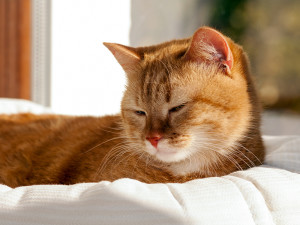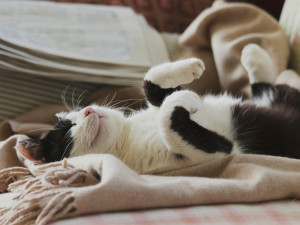What Is Feline Hyperesthesia? Symptoms and Treatments
Aka “twitchy cat disease.”
In This Article:
What Is Feline Hyperesthesia? Feline Hyperesthesia Symptoms and Diagnosis Hyperesthesia Cat Treatment
Feline hyperesthesia syndrome, or FHS, is a collection of symptoms in cats that show extreme agitation, pain, and hypersensitivity of their skin, especially around their backs and tails. It is a curious syndrome in that one specific underlying cause has not been identified and different cats may respond to varied treatments.
Any cat experiencing signs consistent with hyperesthesia syndrome need to see a vet in order to rule out other medical causes for their discomfort and to get effective, targeted treatment. Read on to learn all about this unusual condition.
Check out customizable policies from our friends at Lemonade Pet Insurance—so you only pay for what you need.
How much do you spend on your pet per year?
What Is feline hyperesthesia syndrome?
Feline hyperesthesia syndrome is still a bit of a mystery to veterinarians in that one clear cause has not been identified and different cats may experience varying symptoms. Some classic features of the syndrome are that it causes extreme reactions consistent with pain and anxiety. It is sometimes referred to as “twitchy cat disease” or “rolling skin syndrome” because one of the common signs of the condition in cats is frequently twitching their skin.
All cats have the ability to twitch their skin, which is a reflex known as the panniculus reflex. They do this routinely as a response to contact with their skin; some cats may do this when touched on their backs or when something lands on them like an insect or debris. Cats with hyperesthesia syndrome seem to be on overdrive, though, and twitch their skin much more often, without any obvious cause.
Feline hyperesthesia causes
While one specific cause for feline hyperesthesia syndrome has not been identified, there are a number of possible causes that need to be considered in a cat with these signs. First are physical conditions that may cause itchiness or pain. This includes skin conditions like fleas, mites, allergies, or skin infections. It is also important to look for other causes of pain such as traumatic injuries to the tail, legs, or back, arthritis, bladder problems, or digestive problems.
In other cases when no medical abnormalities are found, neurologic and behavioral causes are thought to play a role as well. For some cats, this can be related to compulsive-type disorders where they overgroom or self-mutilate their skin and may be triggered by stress and boredom. It has also been suggested that some of these behaviors could be the result of a seizure-like disorder in some cats.
Feline hyperesthesia symptoms and diagnosis
Cats with feline hyperesthesia syndrome can experience a wide variety of symptoms related to pain and agitation especially around their skin, back and tail. Some of the most common signs include:
Frequent twitching of the skin
These twitches and muscle spasms are the most consistent sign of FHS and earned it the nickname “twitchy cat disease.”
Episodes of agitation and distress
Many cats with FHS will seem to suddenly get spooked for no reason and may jump, run, puff up their tails, and show other signs of fear like dilated pupils and elevated heart rates.
Vocalizations
During episodes of agitation, cats with FHS often vocalize with distressing cries.
Painful back or tail
Some cats with FHS are reactive when touched on their backs or tail and act like they are in pain. They may bite, run away, or be triggered into an episode of agitation when touched in these sensitive areas.
Overgrooming
Many cats with FHS become hyperfocused on grooming certain areas of their body and may be seen licking or biting at the same areas regularly. This can result in patches of hair loss or more serious damage to their skin.
Self-mutilation
Some cats with FHS will go beyond overgrooming and actually cause serious damage to their skin. One example of this is cats that obsessively chase and bite at their tails until they cause deep wounds to the skin.
Diagnosing feline hyperesthesia syndrome is a multi-step process. While the symptoms alone are often a major clue to the diagnosis, it is important to rule out other underlying causes for a cat’s pain or itchiness.
Cats with these signs should have a thorough medical exam and be screened for more common conditions, like skin parasites, allergies, and orthopedic conditions like traumatic injuries and arthritis. It is also important for your vet to review your cat’s behavioral history to look for signs of stress, boredom, and historical events that may trigger conditions like compulsive disorders. Once your vet rules out other likely causes for pain or itchiness, they may conclude that feline hyperesthesia syndrome is the most likely diagnosis.
Hyperesthesia treatment
The treatment for feline hyperesthesia syndrome is aimed at bringing relief to a cat’s discomfort since there is often no clear underlying cause that can be treated or cured. Most veterinarians use a combination of pain medications and/or behavioral drugs that target anxiety and compulsive disorders.
For some cats, anti-seizure medications have also been effective in controlling their signs. In some cases, behavior modification training techniques may also be helpful when stress and anxiety are thought to be a major factor. The good news is that many different combinations of medications have been found to be effective at controlling and relieving these signs in cats and most cats can achieve remission over time.
Can feline hyperesthesia cause death?
Feline hyperesthesia syndrome is not a fatal disease and does not cause serious damage to vital organs, however, it can become a quality of life issue for some cats and their humans. These cats can experience extreme distress and have behavior changes that may make them unpredictable or irritable. The process of getting a diagnosis and finding the right combination of medications can take time, money, and commitment from pet parents.
In extreme cases in which cats are harming themselves or others, some pet parents may be forced to consider rehoming their cat — or euthanasia if they are unable to afford ongoing care and treatment for their cat. Therefore, it is very important to seek professional help right away if you suspect FHS so you can get your cat relief before more serious complications occur.
When to seek expert help
Any cat experiencing sudden physical or behavioral changes should see a vet right away. Cats are notorious for hiding early signs of illness and pain, so once their signs become obvious or extreme, they tend to be in severe discomfort.
It is also important to consider seeing a specialist or getting a second opinion if your cat is showing signs consistent with FHS, but you don’t feel like they are getting the relief they need. Since FHS can have physical and behavioral influences and require different combinations of medications for different cats, it may be helpful to consult with a veterinary neurologist or certified animal behaviorist to get a comprehensive assessment for your cat.
Bottom line
Feline hyperesthesia syndrome is an unusual condition in cats that is still not well-understood.
Signs of FHS often include pain and agitation and may be related to underlying skin or orthopedic conditions, behavioral conditions, or neurologic problems.
It is important to work closely with your veterinarian or a veterinary specialist to get an accurate diagnosis and treatment plan for cats with FHS. This will avoid more serious complications.
References
Batle, P, et al., “Feline hyperaesthesia syndrome with self-trauma to the tail: retrospective study of seven cases and proposal for an integrated multidisciplinary diagnostic approachopens in new tab,” Journal of Feline Medicine and Surgery, 29 March 2018, vol. 21, no. 2, 178-185.
“Hyperesthesia Syndromeopens in new tab,” Cornell Feline Health Center, 2021.
Pauciulo, C, et al., “Long‐Term Clinical Response to Medical Treatment, Behavioral Therapy, or Their Combination in Cats With Hyperesthesia Syndromeopens in new tab,” Journal of Veterinary Internal Medicine, 17 June 2025, vol. 39, no. 4, pp. E70174.











